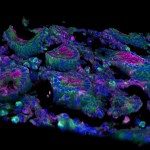Lien vers Pubmed [PMID] – 11507190
J Virol 2001 Sep; 75(18): 8449-60
In contrast to humans, several primate species are believed to have harbored simian immunodeficiency viruses (SIVs) since ancient times. In particular, the geographically dispersed species of African green monkeys (AGMs) are all infected with highly diversified SIVagm viruses at high prevalences (greater than 50% of sexually mature individuals) without evident diseases, implying that the progenitor monkeys were infected prior to their dispersal. If this is correct, AGMs would be expected to have accumulated frequent resistance-conferring polymorphisms in host genes that are important for SIV replication. Accordingly, we analyzed the coding sequences of the CCR5 coreceptors from 26 AGMs (52 alleles) in distinct populations of the four species. These samples contained 29 nonsynonymous coding changes and only 15 synonymous nucleotide substitutions, implying intense functional selection. Moreover, 24 of the resulting amino acid substitutions were tightly clustered in the CCR5 amino terminus (D13N in the vervets and Y14N in the tantalus species) or in the first extracellular loop (Q93R and Q93K in all species). The Y14N substitution was extremely frequent in the 12 wild-born African tantalus, with 7 monkeys being homozygous for this substitution and 4 being heterozygous. Although two of these heterozygotes and the only wild-type homozygote were naturally infected with SIVagm, none of the Y14N homozygotes were naturally infected. A focal infectivity assay for SIVagm indicated that all five tested SIVagms efficiently use CCR5 as a coreceptor and that they also use CXCR6 (STRL33/Bonzo) and GPR15 (BOB) with lower efficiencies but not CXCR4. Interestingly, the D13N, Y14N, Q93R, and Q93K substitutions in AGM CCR5 all strongly inhibited infections by the SIVagm isolates in vitro. The Y14N substitution eliminates a tyrosine sulfation site that is important for infections and results in partial N-linked glycosylation (i.e., 60% efficiency) at this position. Nevertheless, the CCR5(Y14N) component that lacks an N-linked oligosaccharide binds the chemokine MIP-lbeta with a normal affinity and is fully active in signal transduction. Similarly, D13N and Q93R substitutions did not interfere with signal transduction. Thus, the common substitution polymorphisms in AGM CCR5 strongly inhibit SIVagm infections while substantially preserving chemokine signaling. In contrast, polymorphisms of human CCR5 are relatively infrequent, and the amino acid substitutions are randomly situated and generally without effects on coreceptor function. These results support an ancient coevolution of AGMs and SIVagm viruses and establish AGMs as a highly informative model for learning about host proteins that play critical roles in immunodeficiency virus infections.

